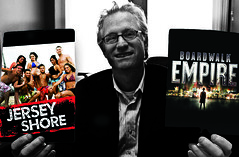Bryant Simon, a history professor and a New Jersey native, was interviewed in a HBO documentary about the history of the New Jersey shore.
You need to be on your tip-top game with your GTL to stay FTD to get the girls to DTF in MIA,” Mike “The Situation” Sorrentino said.
Only true fans of MTV’s “Jersey Shore” can fully understand what Sorrentino meant by these acronyms in the fourth episode of the reality television show’s second season. Last year, cast members popularized what may be their most well-known phrase, GTL: gym, tan, laundry.

Including Sorrentino, the four male members of the cast boast that their abs attract women and are known for their unmistakable and unmovable over-gelled hair, while the women swear by their tans and pouf hairstyles. Week after week, viewers tune in to watch the cast live it up on the coast.
But alcohol and partying have long been part of the culture of New Jersey’s beaches. The new HBO series “Boardwalk Empire,” which premiered Sept. 23, gives viewers a glimpse of what Atlantic City was like during the 1920s prohibition era.
History professor Bryant Simon, a New Jersey native and the author of “Boardwalk of Dreams: Atlantic City and the Fate of Urban America,” said the “Jersey Shore” cast members’ outrageous behavior is entertaining, but it comes at a cost.
“Watching people screw up is entertaining, but to the actual characters, it is physically debilitating,” Simon said. “The cast members play out some parts to which they are exaggerated, but engaging at the same time.”
Because of his extensive knowledge of New Jersey’s history, Simon was interviewed for a HBO documentary that will pair with “Boardwalk Empire.”
“I liked being able to talk to a larger audience and was given time to talk about serious issues including implications, prohibition and class,” he said.
Compared to the modern-day “Jersey Shore,” the new “Boardwalk Empire” depicts a historically accurate 1920s New Jersey, Simon said.
“There came booze, brawls and gambling,” he said. “The boardwalk itself in the 1920s was an affordable luxury of a place for immigrants to say that they made it in America. With a little bit of money, they can act rich, [and] people showed off through brands and cards.”
Simon, who worked in Cape May, N.J., every summer from age 17 to 25, sees similarities and differences between his experiences and those of the “Jersey Shore” cast members.
“I would go [out] like people in the ‘Jersey Shore’ did. My friends and I would walk up the shore and go and cheer particular bands, including Pacific Orchestra, a reggae band,” he said. “We didn’t hook up with tourists.”
While the entertainment value of “Jersey Shore” may be debatable, the show’s ratings are not. According to Nielsen Ratings, 1.38 million viewers tuned in for the premiere of Season 1 on Dec. 3, 2009. The second season premiered on July 29, 2010 and garnered 5.3 million viewers.
Simon said he believes “Boardwalk Empire” paints a very similar picture to what New Jersey was actually like in the era of prohibition.
The premiere of “Boardwalk Empire” marked the premium network’s most-watched premiere of any HBO program in six years. Including two additional repeats that aired, the show attracted a combined 7.1 million viewers.
“[The Jersey Shore is] the intersection between New York and Philadelphia,” Simon said. “I’m not surprised that people are interested. What took them so long?”
Diana Cooper can be reached at diana.cooper@temple.edu.


Be the first to comment